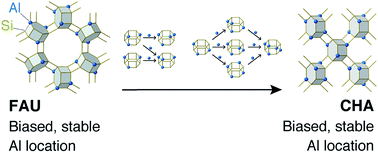当前位置:
X-MOL 学术
›
Chem. Sci.
›
论文详情
Our official English website, www.x-mol.net, welcomes your
feedback! (Note: you will need to create a separate account there.)
Tracking the rearrangement of atomic configurations during the conversion of FAU zeolite to CHA zeolite
Chemical Science ( IF 7.6 ) Pub Date : 2019-08-07 , DOI: 10.1039/c9sc02773d Koki Muraoka 1 , Yuki Sada 1 , Atsushi Shimojima 2, 3 , Watcharop Chaikittisilp 4 , Tatsuya Okubo 1
Chemical Science ( IF 7.6 ) Pub Date : 2019-08-07 , DOI: 10.1039/c9sc02773d Koki Muraoka 1 , Yuki Sada 1 , Atsushi Shimojima 2, 3 , Watcharop Chaikittisilp 4 , Tatsuya Okubo 1
Affiliation

|
In order to realize designed synthesis, understanding the formation mechanism of zeolites at an atomic level has long been aspired, but remains challenging due to the fact that the knowledge of atomic configurations of the species formed during the process is limited. We focus on a synthesis system that crystallizes CHA zeolite from FAU zeolite as the sole source of tetrahedral atoms of Si and Al, so that end-to-end characterization can be conducted. Solid-state 29Si MAS NMR is followed by high-throughput computational modeling to understand how atomic configurations changed during the interzeolite conversion. This reveals that the structural motif commonly found in FAU and CHA is not preserved during the conversion; rather, there is a specific rearrangement of silicates and aluminates within the motif. The atomic configuration of CHA seems to be influenced by that of the starting FAU, considering that CHA synthesized without using FAU results in a random Al distribution. A Metropolis Monte-Carlo simulation combined with a lattice minimization technique reveals that CHA derived from FAU has energetically favorable, biased atomic locations, which could be a result of the atomic configurations of the starting FAU. These results suggest that by choosing the appropriate reactant, Al placement could be designed to enhance the targeted properties of zeolites for catalysis and adsorption.
中文翻译:

跟踪 FAU 沸石向 CHA 沸石转化过程中原子构型的重排
为了实现设计合成,长期以来人们一直渴望在原子水平上了解沸石的形成机制,但由于对该过程中形成的物质的原子构型的了解有限,仍然具有挑战性。我们专注于从FAU沸石中结晶出CHA沸石的合成系统,FAU 沸石是 Si 和 Al 四面体原子的唯一来源,因此可以进行端到端表征。固态29 Si MAS NMR 之后进行高通量计算建模,以了解原子构型在沸石间转化过程中如何变化。这表明FAU和CHA中常见的结构基序在转换过程中并未保留;相反,图案内硅酸盐和铝酸盐发生了特定的重排。考虑到不使用FAU合成的CHA会导致随机 Al 分布, CHA的原子构型似乎受到起始FAU的原子构型的影响。 Metropolis Monte-Carlo 模拟与晶格最小化技术相结合表明,源自FAU的CHA具有能量上有利的、有偏差的原子位置,这可能是起始FAU的原子配置的结果。这些结果表明,通过选择合适的反应物,可以设计铝的放置来增强沸石的催化和吸附的目标性能。
更新日期:2019-08-13
中文翻译:

跟踪 FAU 沸石向 CHA 沸石转化过程中原子构型的重排
为了实现设计合成,长期以来人们一直渴望在原子水平上了解沸石的形成机制,但由于对该过程中形成的物质的原子构型的了解有限,仍然具有挑战性。我们专注于从FAU沸石中结晶出CHA沸石的合成系统,FAU 沸石是 Si 和 Al 四面体原子的唯一来源,因此可以进行端到端表征。固态29 Si MAS NMR 之后进行高通量计算建模,以了解原子构型在沸石间转化过程中如何变化。这表明FAU和CHA中常见的结构基序在转换过程中并未保留;相反,图案内硅酸盐和铝酸盐发生了特定的重排。考虑到不使用FAU合成的CHA会导致随机 Al 分布, CHA的原子构型似乎受到起始FAU的原子构型的影响。 Metropolis Monte-Carlo 模拟与晶格最小化技术相结合表明,源自FAU的CHA具有能量上有利的、有偏差的原子位置,这可能是起始FAU的原子配置的结果。这些结果表明,通过选择合适的反应物,可以设计铝的放置来增强沸石的催化和吸附的目标性能。































 京公网安备 11010802027423号
京公网安备 11010802027423号